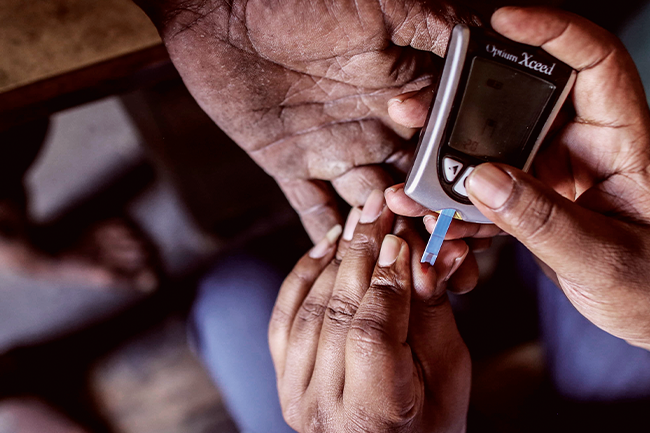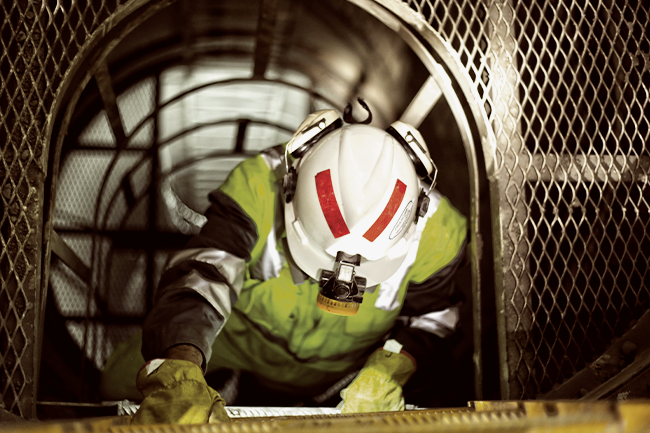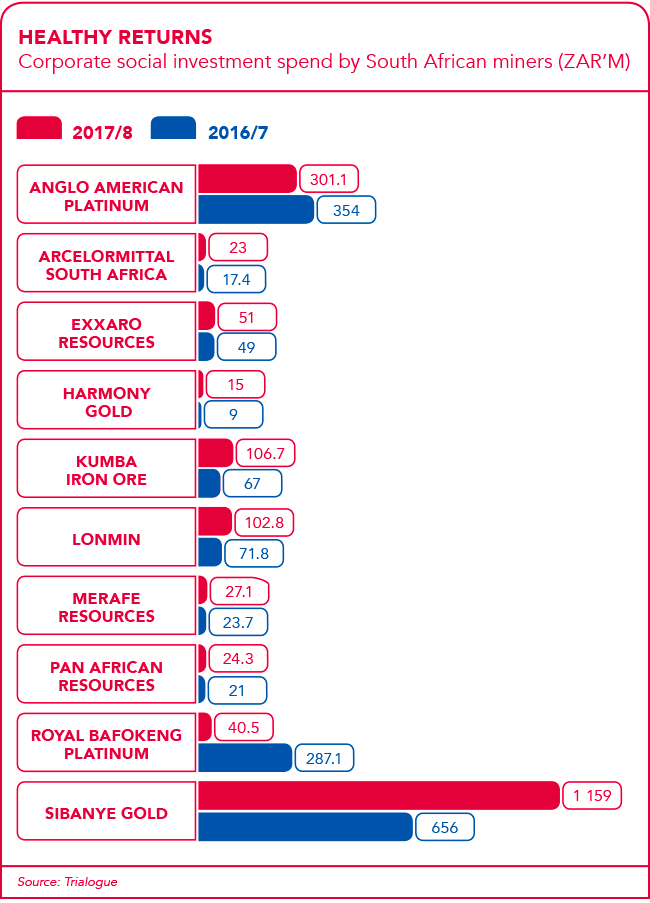Every single day, around half a million people go to work in the South African mining industry, according to the Minerals Council South Africa. Often, they are putting themselves in harm’s way – not only because of the risk of serious accidents, such as rockfalls and gas explosions, but because the industry exposes miners to specific occupational-health issues.
The South African MHSC (Mine Health and Safety Council) – with its slogan, ‘Every mine worker returning from work unharmed every day’ – has set health milestones for the industry to aim for by 2024. Mining firms co-operate by developing programmes to reach these goals, which include reducing toxic particles, such as coal dust, diesel particulate matter and silica, in the atmosphere, and eliminating noise-induced hearing loss caused by loud machinery.
Local mining councils and associations are also key supporters of Vision Zero, a global prevention strategy launched across multiple industries in 2017, which aims for a working environment in which nobody is injured, killed or suffers lifelong harm. As a result of these initiatives, health and safety on South African mines has been incrementally improving in recent years, not least because companies, and investors, are giving more weight to social upliftment and governance issues.
Occupational lung disease (OLD), particularly silicosis, remains a major issue in the gold and coal sectors. This has received quite a bit of attention in the media, largely because of a recently settled class-action case: in 2018, six South African gold companies together contributed more than ZAR5.2 billion towards a trust fund to pay out former mineworkers affected by silicosis and TB. (Pulmonary TB is also associated with silica dust exposure.)
Other health problems can be relieved with technological solutions: for example, at Gold Field’s South Deep mine in Westonaria, silica particle levels have been reduced largely by the installation of improved dust-suppression systems. Similarly, ear-moulded protection devices, such as earplugs or muffs, are issued to all underground employees exposed to high noise levels, and the mine is also introducing low-noise emission equipment and fans. To combat diesel particulate matter, South Deep uses machinery running on lower sulphur-content diesel, while its drill rigs use diesel when travelling but switch to electrical power when drilling.
But other health issues plaguing the mines are less specific, and they’re tied in with the larger socio-cultural context of the mines. These require solutions that are less to do with engineering fixes or big compensation claims, and more to do with community outreach, employee education and lifestyle improvement, and broad access to healthcare.
As with any local industry, mine health issues play out against the prevalence of disease in district communities. ‘The principal health risks facing our employees and our sector are pulmonary tuberculosis and the associated human immunodeficiency virus [HIV] co-infection, both of which are of epidemic proportions in Southern Africa,’ says John Nkosi, group head of sustainable development at Impala Platinum (Implats).

The MHSC milestones also take aim at these chronic conditions. For example, the goal is for TB incidence levels on the mines to fall below the national TB rate by 2024. Accordingly, all the big mines have treatment and prevention programmes in place. For example, Gold Fields’ integrated HIV/Aids and TB strategy at South Deep includes publicity campaigns and condom distribution; voluntary counselling and testing; and free antiretroviral medication provided at on-site clinics.
Increasingly, mines are expanding their health initiatives to deal more holistically with lifestyle-related issues, such as smoking, nutrition and mental well-being. ‘Our health strategy addresses both occupational and non-occupational health, and is focused on preventing harm to our employees,’ says Nkosi.
Every employee undergoes a medical screening at least once a year at health facilities staffed with trained personnel, and medical aid schemes are available to cover non-occupational health. ‘To promote emotional well-being, and to support employees with early symptoms and signs of emotional stress, all operations facilitate access to professional support,’ he adds.
Similarly, Harmony’s health model focuses on prevention and early disease detection. ‘Harmony has come up with an employee psychosocial programme [EPP] that has been developed with the employee’s positive state of physical and emotional wellness in mind, and to enhance employee and workplace effectiveness through prevention, identification and resolution of personal and productivity issues,’ says Tumi Legobye, health executive at Harmony Gold.
‘Harmony has created easy access to health services by investing in medical hubs or “one-stop-health-service” centres that are in close proximity to where employees work,’ says Legobye. ‘This allows employees to receive individualised, comprehensive health services at their convenience.’ These centres are staffed and managed by skilled health professionals, such as doctors, dieticians, social workers and dispensing personnel.
The clinics are well equipped for primary healthcare – allowing, for example, X-rays to be done on-site. Harmony also runs a programme, in collaboration with mining services company TEBA, to support ex-employees who need ongoing care, such as those with chronic or terminal diseases. The results speak for themselves: halved employee death and TB rates over the last half-decade; declining health-related absenteeism and better disability management; and overall, a cost-effective health model.
Of course, mines do not operate in social isolation. In addition to employee health initiatives, the sector is increasingly involving itself in the communities that surround and support their operations. ‘There is a great need for healthcare facilities here in South Africa and Zimbabwe,’ says Implats’ Nkosi. ‘Together with our social partners we build clinics in our areas of operation, renovate hospitals, supply medical equipment and facilitate access to ARVs.’
Recently, Implats donated dental and laundry equipment worth US$133 000 to the Chinhoyi provincial hospital – the largest of its kind in Zimbabwe. ‘As a result of the support provided, the hospital has moved away from conducting tooth extractions only, to providing preventive care and conservative management of dental problems,’ says Nkosi.
This has resulted in a dramatic increase in the number dental patients – from 10 per month prior to the installation of new dental equipment, to an average of 113 per month. Harmony, too, has implemented community health campaigns in the regions where they operate, partnering with NGOs and the government to tackle HIV/Aids and TB, for example. Legobye mentions that they provide free health-screening services to the surrounding communities, and support the government in tracking TB cases.
Likewise, Gold Fields has funded a clinic in the informal Thusanang settlement adjacent to the South Deep mine. ‘South Deep provided furniture for the clinic, while the Gauteng Department of Health has provided medical equipment and personnel to operate the clinic,’ says Sven Lunsche, vice-president of corporate affairs at Gold Fields. ‘The community now has improved access to primary healthcare services, with reduced travel and waiting times to access these services. This supports improved health outcomes for patients. All patients interviewed reported an enhanced feeling of well-being and comfort.’
The clinic opened its doors in 2016, replacing a mobile clinic that used to serve the settlement around just once a week, receiving an estimated 2 000 patients per year. In comparison, the new clinic saw about 23 500 cases – many young children – between August 2016 and September 2019. ‘There are also proven cost benefits to providing care via primary healthcare facilities rather than district hospitals,’ adds Lunsche.
As an industry, South African mines are closing in slowly on the 2024 milestone goals. (Although, as a MHSC presentation from late 2018 points out, high exposures to occupational hazards and loss of lives remains unacceptable.) ‘We will continue with our initiatives to educate our employees and reinforce messages around managing health hazards,’ says Nkosi. ‘We plan to continuously improve our implemented activities related to culture transformation, financial well-being and wellness. Our ultimate aim is to achieve and surpass the occupational health milestones set for the South African mining industry, across all our operations.’
Certainly, some advances will come from improved technology – Gold Fields, for example, is working to introduce cleaner, safer vehicles, as well as innovative machinery to allow material to be moved and loaded remotely via an operating room on the surface.
But perhaps the more durable health gains will result from investment in community-based initiatives such as Thusanang, and worker outreach programmes such as Harmony’s EPP. As Nkosi says: ‘The biggest challenge, as with all social initiatives, is resources.’









